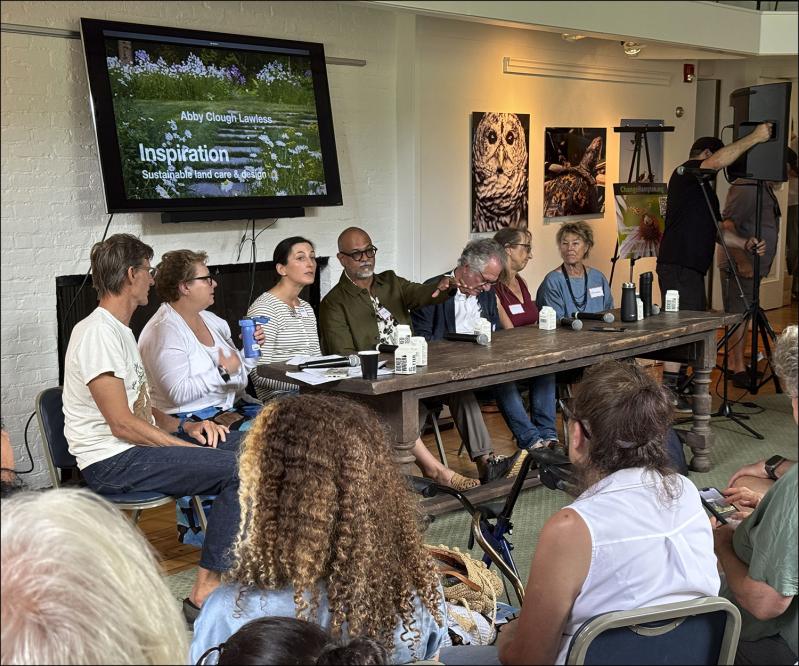“We know we are living through some very dark times,” said Gail Pellett, a co-founder of ChangeHampton, to a standing-room-only crowd attending a panel discussion Sunday about landscaping sustainability and community action.
It was called “How to Move the Eco-Needle on Our Lands.”
“We at ChangeHampton consider ourselves hope-peddlers, and believe in the radical hope that comes with organizing and activism. Change means we have to ask the tough questions,” Ms. Pellett said.
Members of the six-person panel, held at the Nature Conservancy headquarters in East Hampton, were Edwina von Gal, founder of the Perfect Earth Project; Mariah Whitmore, a partner at Whitmores Tree Nursery and Landscaping; Nilay Oza, founder of Oza Studio Architects; Michael Schultz, an agent with Bespoke Real Estate; Town Councilwoman Cate Rogers, and Filippine de Haan, a landscaper and “enviro-activist.”
Each panel member had a few minutes to mull how best to move the seemingly leaden “eco-needle.” Was it the stick of legislation, the carrot of beauty, the thrill of creating a new aesthetic, or perhaps some good old shame?
“What your massive lawn is saying about you is, ‘I don’t care. I don’t care about my family, my kids, my pets, or the planet,’ ” said Ms. von Gal.
“What we’re trying to do here is convert,” said Biddle Duke, the moderator, who is a board member of ChangeHampton. “We’re interested in getting people with acres of lawn to change. What is their resistance?”
To that end, Ms. von Gal said any resident of the South Fork could go to her website (perfectearthproject.org/living-lands-long-island) and sign up for a free one-hour evaluation of their property.
Ms. Whitmore said she was seeing signs of a shift away from trophy lawns, but that many of her clients were detached from, or uninterested in, the natural histories of their properties. They don’t appreciate, she said, that a healthy landscape exists as a dialogue with the native insects, birds, and aquifer below.
“The comment I get a lot is, ‘Do you know what a golf course looks like? That’s what I want my lawn to look like.’ “
The assembled crowd groaned.
“I don’t have a compelling argument that I’ve found for those people yet,” Ms. Whitmore admitted.
Still, she said, there are signs of hope. Some people want to lower their lawn-mowing bills; others are worried that the fertilizers, pesticides, and constant irrigation needed for a “Hamptons lawn” could harm their children or pets.
“There are ways to ease people in, and once they see it’s successful, they’re willing to hear more.” Legislation, Ms. Whitmore noted, could be an important part of the answer. For example, the seasonal ban of gas-powered landscaping equipment in many municipalities has made it easier for her company to convert all its equipment. “We don’t have any gas blowers anymore,” she said, to raucous applause.
ChangeHampton handed out fliers to the audience urging people to write their state legislator to support the “Electric Landscaping Equipment Rebate Program,” also known as Assembly Bill A2657. The bill, already passed by the State Senate, would provide point-of-sale rebates to landscaping companies that switch to electric tools.
Mr. Oza agreed that legislation could be important. He has had to guide clients through mandated replantings in the past, he said. “It’s something I try and turn into a design discussion rather than a punitive sanction.”
As an architect, who is often one of the first professionals to speak with someone who’s just bought a property, he said it was important to get the conversation moving in the right direction early. “I really push back on clients wanting to take down mature trees,” Mr. Oza said. “It is truly a gut punch for me when that happens. I embrace mature trees and build and design around them. It is glorious when that comes together.” Again, the crowd applauded.
Unfortunately, it was agreed, fear of ticks and the diseases they carry inform many landscaping decisions. Aggressive, fear-based marketing campaigns by East End pesticide companies don’t help either. Mailers with enlarged photos of the hell-dwellers arrive daily, and new homeowners have bought the misinformation. Their friends spray, so they spray.
“What scares my clients most,” said Mr. Schultz, the real estate broker, “is the fear of deer and deer ticks. It’s not that they like grass, but it’s hard to educate people. People want to buy a house with a farm field near, and they want to make sure that farm is farmed organically. But nevertheless, their very own lawns are filled with pesticides and fertilizers.” Even short-term renters demand treated properties, he said.
Ms. von Gal put it succinctly, “They’ll walk across their toxic lawn to get to organic kale. There is this serious disconnect.”
In other words, the science of pesticides doesn’t hold up, but it’s hard to fight the relentless marketing. “We know that if people use pesticides the incidence of disease is not going down,” said Ms. de Haan. “There is no relationship between the use of pesticides and tick-borne illnesses,” Instead of spraying, she said, a far better approach is a nightly tick check.
“We need to check for ticks like we brush our teeth,” Ms. de Haan said.
Another big topic was water quality, though that was less about aesthetics and more about engineering.
“On a busy summer weekend, 300,000 people between Shinnecock and Montauk are pooping and peeing into the ground, essentially,” said Mr. Duke. “That’s a lot of nitrogen going into our bays and ponds. And Suffolk County has the highest chemical use of any county in New York State.”
“It’s not regulations or the other, ‘We have to do everything,’ ” said Ms. Rogers. She pointed to a recent code amendment limiting the maximum house size in the town, and to the water quality grants disbursed by the town, as positives.
In the end, all agreed that the needle would move if people were better educated and if the message of sustainability were popularized and spread.
“Most of you I have seen here before,” said Ms. von Gal. “People ask, ‘You’re always preaching to the choir. Does that depress you?’ ‘No,’ I tell them, because you keep coming back.’ But also, what does the choir do? A choir sings. Now, go out there with this song to sing it to our community.”




